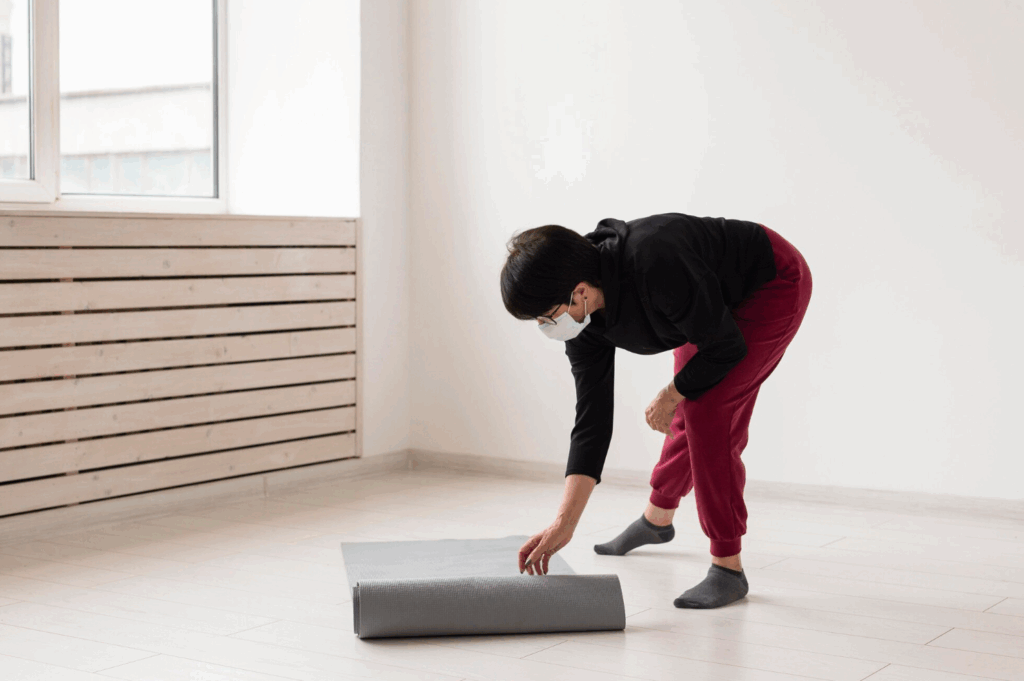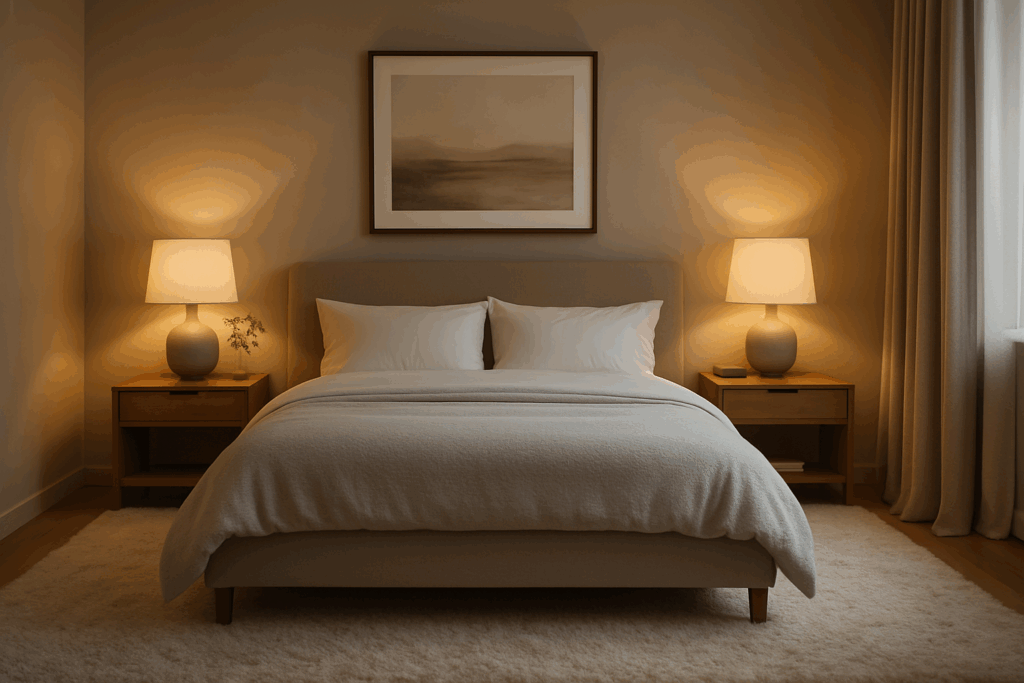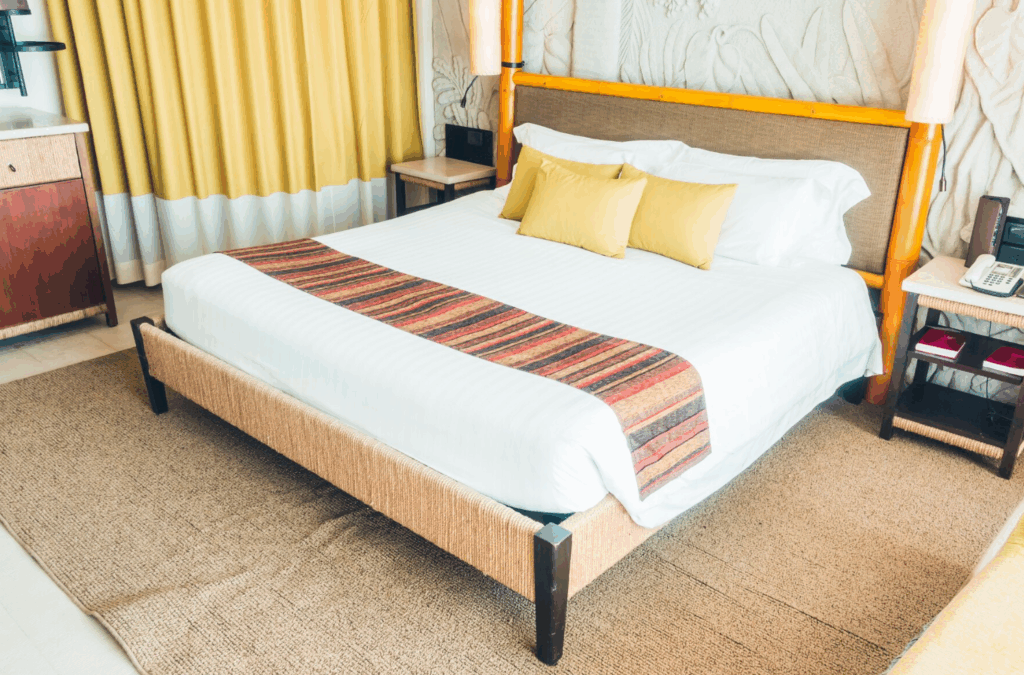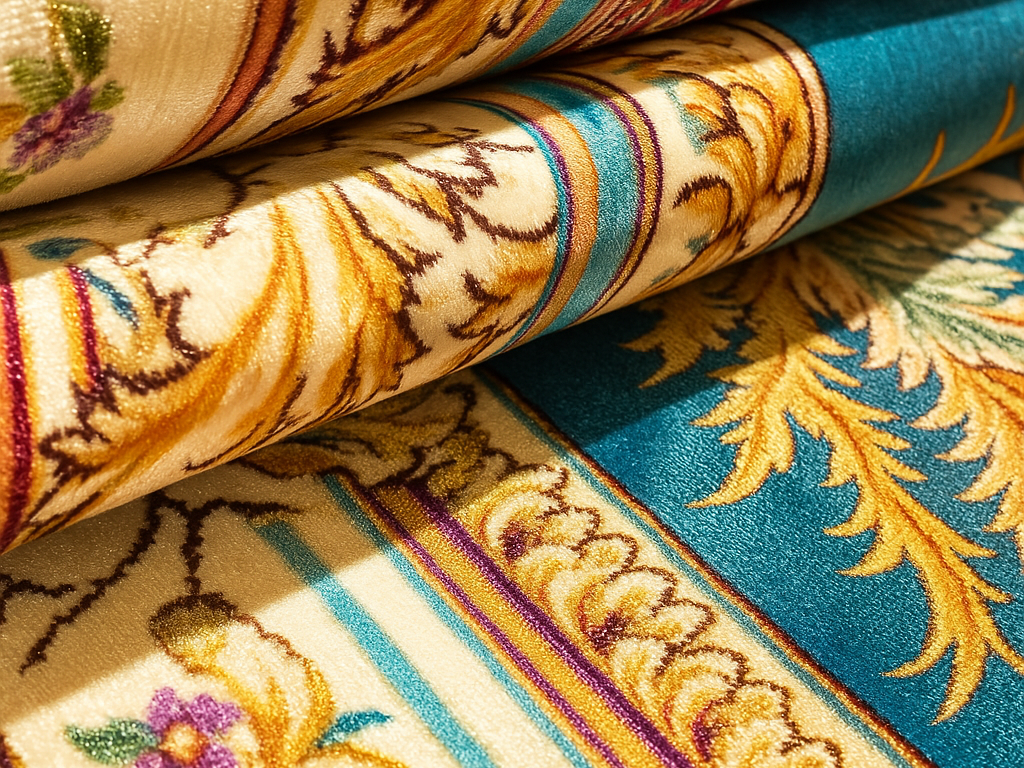Your bedroom should be more than just a place to sleep — it should feel like a sanctuary, a haven of comfort and style. One of the easiest and most effective ways to elevate that space is by adding a well-chosen rug under your bed. A high-quality rug not only enhances the tactile experience underfoot, but also anchors the bed, ties the décor together, and adds warmth and sound-absorption to your room. According to design experts, a rug can serve as a “visual extension of your bed” and provide practical benefits like noise reduction and improved comfort underfoot.

In this guide from Valhak, we’ll walk you through everything you need to know—starting with whether you even need a rug, then moving on to size, material, style, placement, installation and common pitfalls.
1. Do I Need a Rug in My Bedroom?
When you walk into your bedroom, you’ll want it to feel like a sanctuary — a place of rest, retreat and softness underfoot. That’s where a thoughtfully placed rug can make a real difference. Here are the key reasons to consider one:
- Comfort & warmth. A rug adds a soft, warm surface to step on when you get out of bed. Especially if you have hard-floors (wood, tile, laminate) the cold first step can be off-putting. Interiors experts say placing a rug under the bed “anchors the sleeping area and gives your feet something plush to land on.”
- Defining the space. A rug visually defines the “bed zone” within your room, especially helpful in large bedrooms or open-plan suites. It helps the bed feel grounded rather than floating in the space.
- Style & acoustics. Rugs soften acoustics, reduce floor echoes, hide small imperfections, and provide texture, colour, material richness — all of which enhance the look of your bedroom.
- Protection & layering. If you have a hard floor or even carpet, a rug can protect the surface, layer in more design interest, or be used to update the look without a full flooring renovation.
2. 침대 밑에 깔기 좋은 러그 크기

Choosing the right rug size under your bed is one of the most important steps. If it’s too small, it will look mis-scaled; if it’s too large, it may overwhelm the room or interfere with other furniture. Here are guidelines backed by interior-design sources:
- Rule of thumb: Allow about 18–24 인치 (≈45–60 cm) of rug extending beyond the sides and foot of the bed.
- For specific bed sizes:
- Room size matters. Even when the bed is standard, the room’s floor space, traffic paths, doors, other furniture need consideration: Choose a rug size that leaves some floor visible around the perimeter.
- Furniture coverage. You must decide if you want just the bed on the rug, or also the nightstands (and maybe bench or chairs) to sit on it. More surface under the rug requires larger size.
Practical examples for your brand (Valhak) to convey:
- If the bed is a queen and room is medium-sized: Recommend list an 8’×10’ rug so it extends ~2 feet beyond bed sides and foot.
- If room is large (master suite) and bed is king: Suggest 9’×12’ to comfortably host bed + dual nightstands + bench at foot.
- In smaller spaces or guest rooms: A 6’×9’ rug positioned so the front 2/3 of the bed is on it will still work and look intentional.
3. Style Considerations: Materials, Texture & Colour
Once you’ve sorted the size, the visual and tactile qualities of the rug come into play. These elements determine both how the rug feels and how it 외모 in your bedroom.

자료
- Natural fibres like wool are highly recommended: warm underfoot, durable, good acoustically, and age gracefully. (One guide states wool “can handle foot traffic, keep rooms warm… is easy to clean.”)
- Flat-woven or low-pile rugs can work well when you have under-bed drawers (so the rug doesn’t bunch or hinder movement).
- In budget or modern contexts: Synthetic blends (polypropylene, nylon) may work, just check for comfort and maintenance.
- 다음 사항도 고려하세요. 파일 높이: a high-pile shag may feel luxurious but could be harder to clean and might interfere with furniture legs (e.g., nightstand legs).
- Padding: Use a rug pad underneath to enhance comfort, help anchor the rug, prevent slipping and extend life (especially important under a bed).
Texture & pile
- Texture adds character: ribbed, loop-pile, cut-pile, or hand-loomed variations all give different impressions. A subtle texture creates interest without overwhelming.
- Think about foot-traffic: the sides of the bed are high-traffic (stepping out of bed). So a rug with some durability is wise.
- Contrast: If your room has lots of smooth surfaces (hardwood floors, sleek furniture), a textured rug adds warmth and softness. Alternatively, if the room is busy with patterns, a smoother, more understated rug might be best.
Colour & pattern
- Colour: Lighter-toned rugs (cream, light grey, pale taupe) will make a space feel larger and brighter. Darker tones make a room feel cozier, but may shrink the perceived space.
- Pattern: If your bedding and furniture are plain, a patterned rug introduces visual interest. If everything is already pattern-heavy, go with a simpler rug to balance.
- Coordination: The rug should harmonize with existing elements – bedding, curtains, wall colour, flooring tone – but need not match exactly. A complementary accent is better than a forced match.
- Edge visibility: Since part of the rug will extend out from the bed, the edges will be visible — consider how the border or design works when seen at foot and sides.
Brand voice “Valhak” suggestion: Emphasise your rug craftsmanship, material quality and how your luxury rugs create that ‘hotel-feel’ underfoot. You might mention specific collections (if relevant) or fibre choices (e.g., “hand-loomed wool” or “eco-friendly jute”) to reinforce quality.
4. How to Position a Rug Under Bed
Positioning the rug correctly is just as important as choosing the size. The goal is both aesthetic balance and functional comfort. Here are the main considerations:

Orientation
- The rug should usually run perpendicular to the bed’s length, meaning the longer dimension of the rug runs from the head toward the foot of the bed (or aligned with the width of the room).
- This allows the rug to extend out on both sides of the bed, giving ample stepping surface when you get in/out.
Depth & coverage
- A common approach: start the rug just a few inches in front of (or even under) the headboard, and let the rug extend beyond the foot of the bed by 18–24 inches (45–60 cm) or more.
- Some designers instead start the rug about one-third of the way down the bed so the headboard is not on the rug but the foot and sides are—this is helpful if the room is narrow.
- Whether to place the nightstands on the rug is a matter of style:
Distance from walls and other furniture
- Leave a visible border of flooring around the perimeter of the rug (especially in larger rooms) — typically 10-24 inches (≈25-60cm) from the walls. That helps the rug look integrated, not wall-to-wall.
- Consider doorways, wardrobes, dressers: Make sure the rug does not interfere with door swings, sliding drawers, or restrict movement.
Anchoring & visual balance
- The bed should feel anchored within the rug. Many designers say: at least the front legs of the bed (and ideally the nightstand legs) should sit on the rug, so the rug visually holds the furniture together.
- If only the lower portion of the bed (about two-thirds) sits on the rug, that can still work and is a common layout for smaller rooms.
Brand-specific tip from Valhak
- In your product pages and blog, you might highlight typical room layouts with your rugs: e.g., “For our 8 × 10 suit-and-room Rug Model A, position it so that you can get two feet of rug on each side of a queen bed and still have room for a bench at the foot.”
- Provide a simple diagram or measurement checklist to help users visualise: bed size, rug size, clearance from walls/furniture.
5. How to Slide a Rug Under a Bed
Getting the rug physically under the bed can be a little tricky — especially if the bed is heavy, or if it has a platform or skirt. Here’s a practical process:
- Clear the space. Remove items from the sides and foot of the bed (nightstands maybe stay, but move anything that can shift easily).
- Vacuum or prepare the floor. Since the rug will be under the bed and likely less cleaned later, ensure the floor surface is clean and smooth.
- Use furniture sliders or lift slightly. If your bed has legs, you might place sliders under them so you can push the bed slightly forward or lift edge of bed to slide rug underneath. Some guides recommend placing bed’s legs on sliders to make the process easier.
- Roll the rug. A suggested method: Start rolling the rug from one end and slide it gradually under the bed until the correct position is achieved. Rugs-Direct says: “The best way to slide a rug under a bed is to gradually roll it beneath it.”
- Check the placement. Once the rug is under, centre it under the bed, ensure sides extend evenly, the foot extension is correct, and any visible edge is aligned.
- Refit furniture. Carefully move the nightstands (if they are going on the rug) and any other furniture back into place. Ensure legs sit on the rug if intended.
- Secure and flatten. Use a rug pad underneath to prevent slipping, minimise creases, and lift slightly to tuck or straighten as needed. Especially if your bed skirt is long, ensure the rug sits under it smoothly.
6. Troubleshooting Common Issues
Even when you follow all the guidelines, things may go slightly off-plan. Here are common issues homeowners face when placing a rug under a bed — and how to fix them.

Issue: Rug appears too small (looks islands under the bed)
- If the rug doesn’t extend sufficiently beyond the bed sides/foot, the bed may look like it’s “floating” on a small rug. As per guides: a rug “too small makes furniture look crowded and affects the room’s balance.”
- Fix: Consider layering another smaller rug (two small side rugs) or upgrading to a larger size. You might also shift the bed so that more of the rug is visible (if room allows).
Issue: Rug is too large (touches walls / covers too much floor)
- If the rug nearly meets all walls, it can give a “벽부터 바닥까지 이어지는 카펫” effect, which may defeat the intention of the rug as a design anchor. Design guides advise leaving exposed flooring around the perimeter.
- Fix: Pull the rug a few inches away from walls, or fold/tuck under if possible (though this is not ideal). In future, pick a slightly smaller rug.
Issue: Rug slips or bunches under bed
- With heavy 가구 like a bed, rugs can shift. This creates wrinkles, safety issues, or visual disruption. “Edges can still bunch up to cause a tripping hazard.”
- Fix: Use a good non-slip rug pad under the rug. For heavy frames, ensure they sit firmly on the rug (or floor) and that the rug is flat before placing the bed.
Issue: Nightstand or furniture legs not on the rug — visual imbalance
- If the bed is on the rug but nightstands sit off-rug, you may get a mismatched look. Designers recommend at least the front legs of all major furniture items to sit on the rug to ‘anchor’ it.
- Fix: Either shift the rug (or furniture) so nightstands are on the rug, or accept a different layout and select the rug size accordingly.
Issue: Rug interferes with drawer movement or door swing
- If the rug obstructs a dresser drawer or door swing, you’ll have functional issues. Measurement is key.
- Fix: Choose a rug size or placement that leaves clearance for movement. Sometimes this means a shorter rug length or pulling the rug a foot away from the wall with doors.
Issue: Rug material or pile too high under bed skirt/legs
- If the rug’s pile is too thick, bed frames or skirts might walk rough or shift.
- Fix: Select a lower-pile variant or ensure bed frame clearance is adequate. Alternatively use furniture coasters/leg protectors.
7. 결론
Placing a rug under your bed is more than just a decorative afterthought — it’s a design move that blends comfort, style and function. When done correctly, it anchors your bed, adds texture and warmth, and elevates your bedroom into a restful retreat.
8. 자주 묻는 질문
Q1: Can I place a rug under a bed if I already have wall-to-wall carpet?
A1: Yes — you can layer an area rug over carpet. It still adds style and anchors the bed, though extra padding or a non-slip underlay may help.
Q2: What if my room is small and I can’t find a rug big enough to extend 18-24 inches on all sides?
A2: Choose the largest rug your space allows, and position it so the front two-thirds of the bed sit on it. You can also use smaller rugs on the sides of the bed instead of one large rug.
Q3: Should the nightstands sit on the rug too?
A3: It depends on your style and room size. For a unified look, having the bed + nightstands on the rug is ideal. But if space is limited, just the bed on the rug still works. Just be mindful of visual balance.
Q4: What is the best way to clean and maintain a rug under a bed?
A4: Regular vacuuming, rotating the rug periodically (especially under bed legs), addressing spills promptly, and using a good rug pad to reduce wear. Also check manufacturer’s care instructions for the fibre type.
Q5: Does the shape of the rug matter under the bed (e.g., round vs rectangular)?
A5: Rectangular rugs are the most common and easiest to fit under a bed and nightstands. Round rugs can work if you have a more open-plan or circular layout, but they may not give the same symmetrical framing of the bed.


